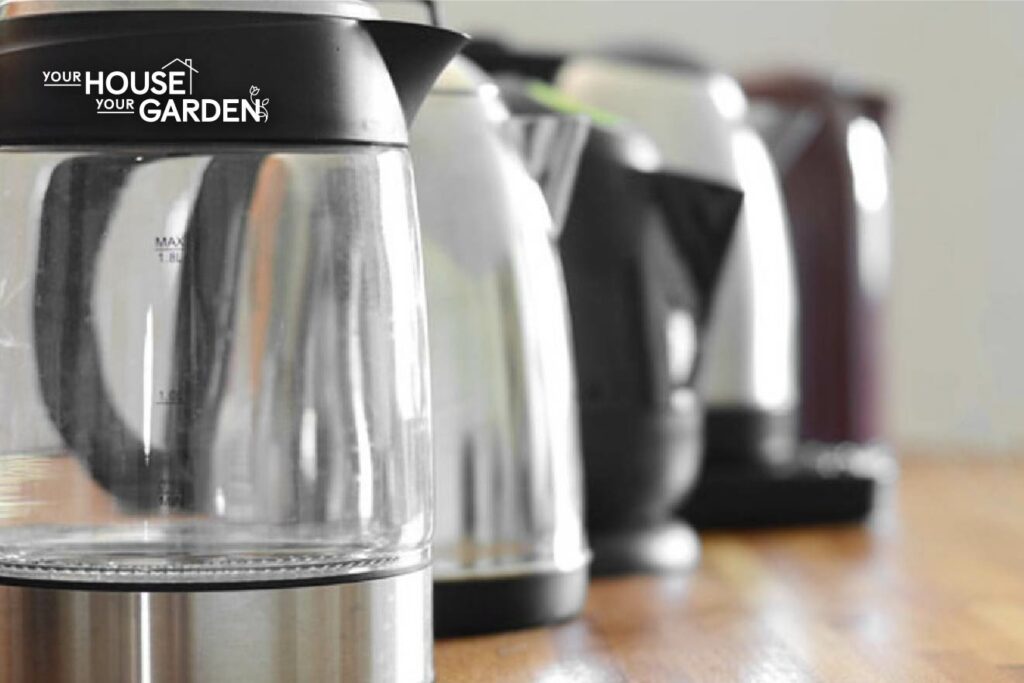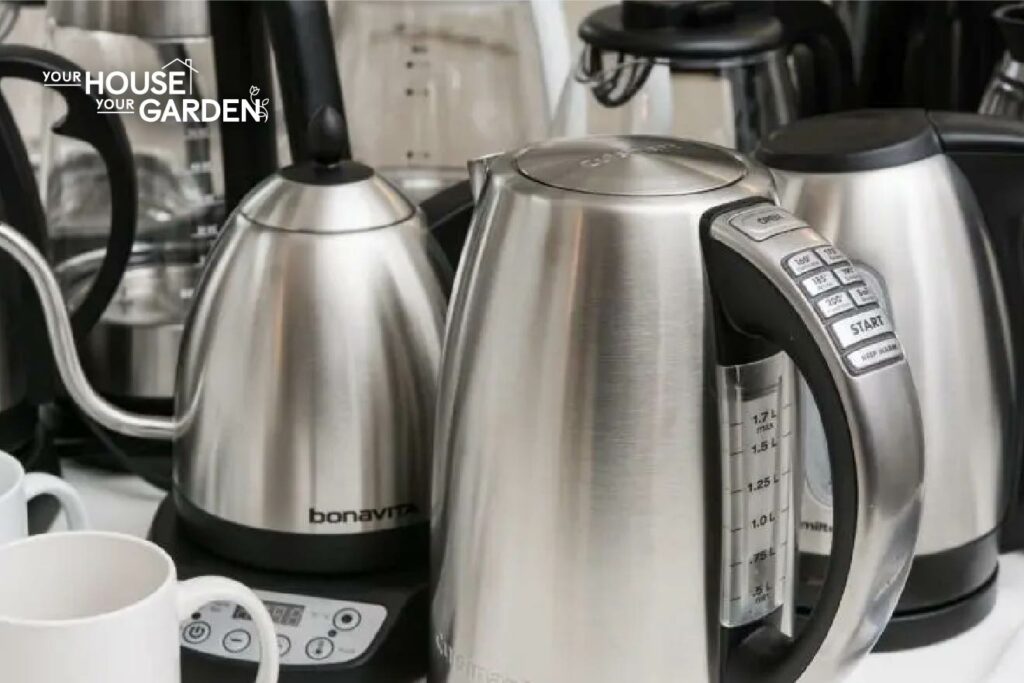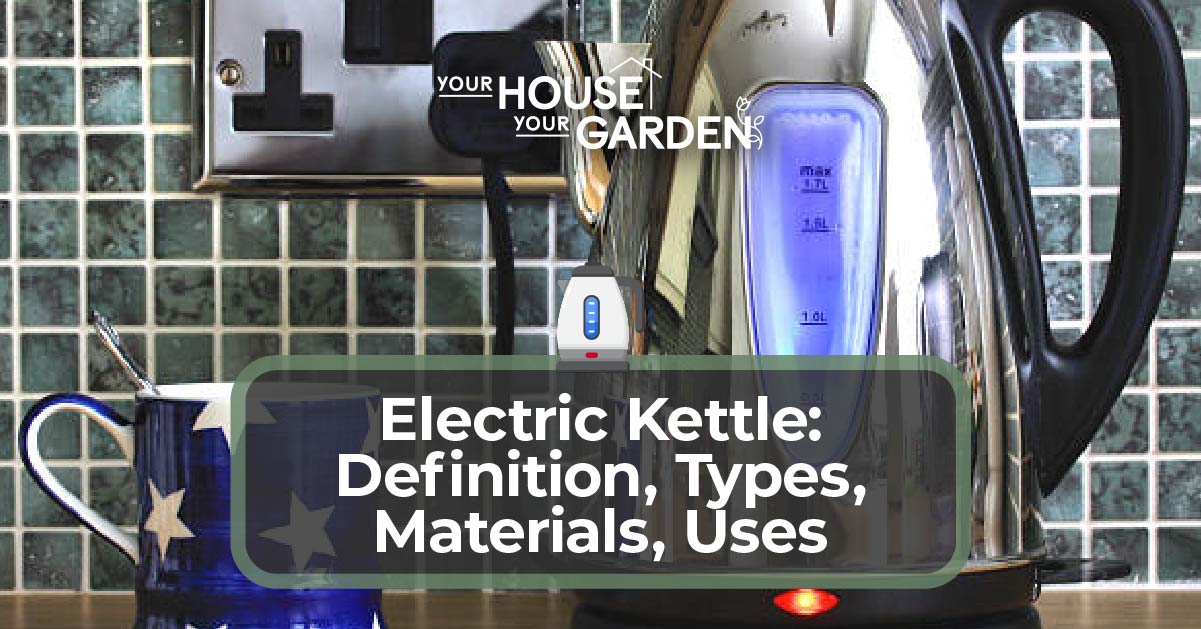An electric kettle is a small appliance used to heat water. The most common use of an electric kettle is to boil water for tea but they have other uses like heating coffee or making soup.
The preferred type of electric kettle is stainless steel. Stainless steel electric kettles are heat resistant and provide even heating. Stainless steel is also less prone to rust or peeling, unlike copper or plastic electric kettles. A stainless steel electric kettle costs more but also lasts longer than other types of electric kettles, like plastic or copper.
An electric kettle most often comes in a round shape with a pointed spout that pours the heated liquid into a cup or bowl. Electric kettles are available in all different sizes, with the size of the kettle affecting how much liquid you can make at one time. An electric kettle is different from a stovetop kettle in that it is powered by a plug in the wall, rather than the stove.
The history of the electric kettles dates back to the 1890s. Carpenter Electric Company released an electric kettle in 1891, but it took a long time to heat. The electric heater has since been improved to a product that is widely used in European countries. While fewer U.S. households use the electric kettle, they are readily available to buy.
Materials for Electric Kettle
The best material for an electric kettle is stainless steel. Stainless steel electric kettles cost more than copper or plastic electric kettles but also last longer.
The most affordable type of electric kettle is plastic, but plastic electric kettles are prone to melting or peeling. An electric kettle made with glass or copper materials may be cheaper than stainless steel kettles but more expensive than plastic kettles. Stainless steel electric kettles are resistant to rust and tarnish.
If you’re concerned about health, you may want a stainless steel or glass electric kettle. There have been some concerns about the boiling heat of an electric kettle melting plastic and peeling into your kettle. Stainless steel electric kettles are also more environmentally friendly than other types of electric kettles.
Types of Electric Kettle
The types of electric kettles include:
- Stainless steel electric kettle: A stainless steel electric kettle includes stainless steel materials that are durable, rust-resistant, and modern.
- Cast iron electric kettle: A cast iron electric kettle is long-lasting and heavy. Cast iron electric kettles may lead to an aftertaste.
- Copper electric kettle: A copper electric kettle is good for consistent heating but is prone to tarnishing.
- Glass electric kettle: A glass electric kettle is made with glass materials and offers a see-through design so you can tell when the water is boiling.
Sizes of Electric Kettle
Electric kettles come in different sizes, ranging from four to eight cups. The size and quantity of drinks you want to make using your electric kettle determine the best size of the electric kettle for your household.
If you have one to two people in your household, an electric kettle that holds four to six cups may be sufficient. If you have four or more people in your household, you may want an electric kettle closer to eight cups.
Does Size Affect Electric Kettle’s Usage?
Yes, the size of an electric kettle can affect how long it takes to boil water. If you have a smaller electric kettle, it is capable of boiling water faster but holds fewer liquids. If you only want enough water for one or two cups and try to use a larger kettle, it can lead to your water burning faster.
Use Cases of Electric Kettles
A use case of an electric kettle is described as the ways in which you can use it. A few use cases of electric kettles include:
- Boil water for tea
- Heat coffee
- Make soup
- Rehydrate vegetables
- Cook oatmeal
- Boil eggs
- Water plants
- Cook instant noodles
- Do a facial treatment
- Cook just add water meals
- Cook rice
Once you learn how to use an electric kettle, you’ll find that it has many uses beyond that of making tea.
Do Electric Kettles Have Health Benefits?
Yes, electric kettles have many health benefits. Tea is a healthy beverage that can boost your immune system, reduce inflammation, and reduce the chances of common health diseases. Tea is also high in antioxidants. Different types of tea can also be used for different purposes, like relaxing and promoting sleep.
Most Known Electric Kettle Brands
Some of the best electric kettle brands include:
- Best overall electric kettle brand: KitchenAid
- Best value electric kettle brand: Hamilton Beach
- Best splurge electric kettle brand: Breville
- Best stainless steel electric kettle brand: OXO

Electric Kettle Lifespan
The typical lifespan of an electric kettle is between four to five years. How long an electric kettle lasts depends on the initial quality and maintenance and cleaning schedule. The following factors affect how long an electric kettle lasts:
- Initial quality: The initial quality of your electric kettle affects how long it lasts. A stainless steel electric kettle lasts longer than a glass or plastic electric kettle.
- Cleaning schedule: Cleaning out your electric kettle in between uses can help it last longer. This includes thoroughly removing the parts and all water.
- Frequency of use: How often you use your electric kettle also affects its longevity. If you use your electric kettle daily, or multiple times per day, you can expect it to wear out faster.
- Uses: What you use your electric kettle for can affect how long it lasts. Boiling water leads to less wear and tear than cooking meals using your electric kettle.
The average cost of an electric kettle is between $20-$200. The brand and material affect the cost of an electric kettle. Some brands, like Breville and OXO, made with stainless steel materials, are likely to be more expensive than other electric kettles.
How Does Culture Affect the Usage of Electric Kettle?
The electric kettle may have been invented in the United States, but few households in the U.S. use them. European countries use electric kettles the most, with countries like London and the U.K. using them most frequently. While Americans and Canadians still consume tea and coffee, many use coffee makers or boil water using a pot for these beverages.
Relevant Kitchen Tools to Electric Kettle
Some kitchen tools are relevant to the electric kettle, including:
- Coffee maker: A coffee maker is similar to an electric kettle because both are small appliances that heat liquids. A coffee maker is different from an electric kettle because its primary purpose is to make coffee, whereas an electric kettle has a variety of different purposes.
- Pots: A pot is similar to an electric kettle because both can be used to heat water. A pot is different from an electric kettle because it uses the stove to heat water.
- Teaspoon: A teaspoon is related to an electric kettle in that both are used when making tea. A teaspoon is different because it’s a kitchen utensil, whereas an electric kettle is an appliance used to heat water.
- Electric microwave: An electric microwave is similar to an electric kettle because both use electricity to heat. An electric microwave differs from an electric kettle because it’s capable of cooking frozen foods, whereas an electric kettle heats water or other liquids instead.
Difference Between an Electric Kettle and a Coffee Maker
The primary difference between an electric kettle vs a coffee maker is the purpose of each appliance. An electric kettle heats water in preparation for tea or coffee. A coffee maker heats water from a reservoir and then pushes it through to the coffee grounds to make coffee.
Another difference between an electric kettle and a coffee maker is the versatility of each appliance. A coffee maker is used for making coffee, whereas an electric kettle can be used for a variety of other purposes, like also making coffee or boiling noodles.
Features of a Good Electric Kettle
There are some features to look for when choosing the best electric kettles, including:
- Speed: Some electric kettles are capable of heating water faster than others.
- Size: The size of an electric kettle affects the number of drinks you can make.
- Appearance: Electric kettles come in all different designs and colors.
- Ease of use: Some electric kettles are easier to use.
- Comfort: Some electric kettles have comfort handles for easier serving.
- Dishwasher safe: An electric kettle with dishwasher-safe parts can make it easier to keep it clean.
- Limescale filter: An electric kettle with a limescale filter filters out impurities in the water while heating.
- Cordless vs corded kettles: Electric kettles are available corded or cordless. A cordless electric kettle uses a battery for heat.
- Multiple temperature settings: Some electric kettles come with multiple temperature settings so you can choose your preferred one.
- Level markings: An electric kettle with a water level marking lets you measure how much water you have.
- Keep warm: An electric kettle with a keep-warm function can keep your water or coffee warm longer.
Components of an Electric Kettle
An electric kettle is made up of the following parts:
- Kettle body: The kettle body is the main portion of the kettle, where you place the water you want to heat.
- Controls: The controls are where you power on or off the electric kettle, or where you set your preferred temperature.
- Power cord: Electric kettles are powered by a cord that goes into an outlet unless you get a cordless electric kettle.
- Temperature sensors: Temperature sensors let you know when the water is boiling and hot enough for tea.
Repair Options for an Electric Kettle?
If your electric kettle breaks, you may be able to replace parts rather than replace the whole appliance. A few replacements parts include:
- Holder: The holder is the base of the electric kettle and is prone to breaking if you drop it. You can replace the holder with a new reservoir.
- Filter: Changing out the filter can help your electric kettle last longer and lead to better quality liquids.
- Thermostat: The thermostat, which measures the temperature of the liquids, may stop working over time.
- Switch: The on/off switch can wear out over time, especially if you use your electric kettle a lot.
Difference Between an Electric Kettle and a Stove Kettle
The primary difference between an electric kettle and a stove kettle is how each appliance is heated. An electric kettle is powered by an outlet whereas a stove kettle uses the stove for its heat.
Another difference between an electric kettle and a stove kettle is the size of each appliance. An electric kettle is a small appliance that can be stored away in between uses and a stove kettle is a large appliance that stays in the same spot in your kitchen.

Electric Kettle Name Origin
The electric kettle gets its name from its power source, which is electricity. The name kettle comes from the cauldron, which a kettle resembles.
You can spell electric kettle as: E-l-e-c-t-r-i-c k-e-t-t-l-e.
To pronounce electric kettle, say: (Uh-lek-truhk keh-tl).
Electric Kettle History
The first electric kettle was invented in 1891 by Carpenter Electric Kettle. Two years later, Crompton & Co also released a version of the electric kettle. Both versions were faulty and took over 10 minutes to heat. The first electric kettle that resembles what we know today was invented by Bulpitt & Sons in 1922. This electric kettle became the standard.

